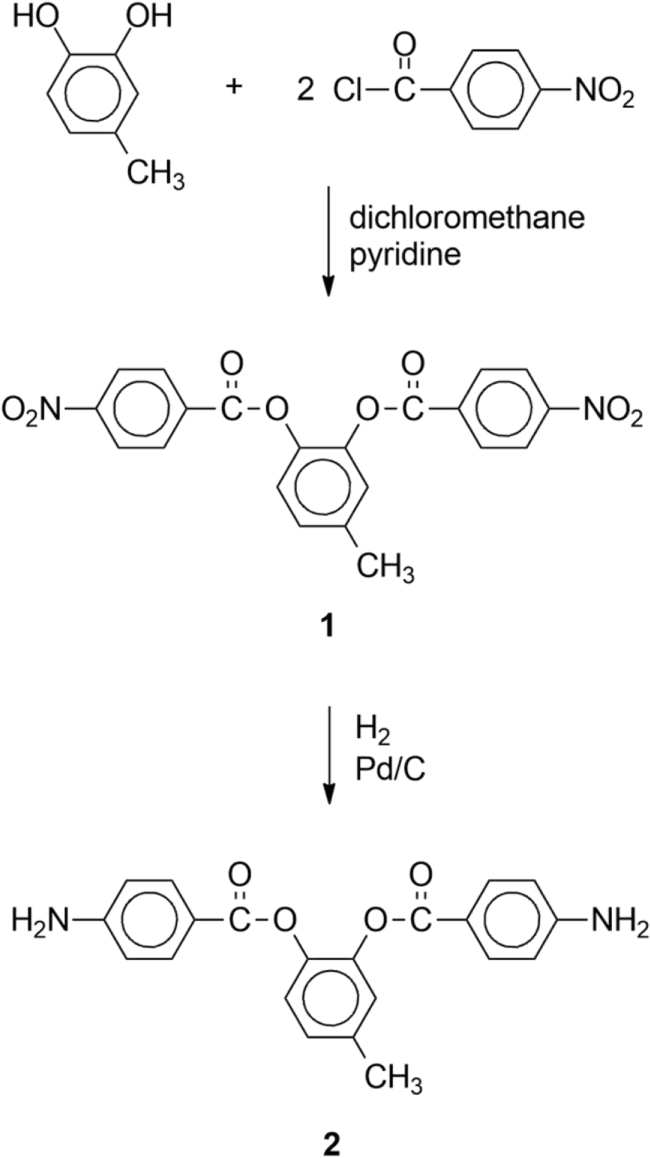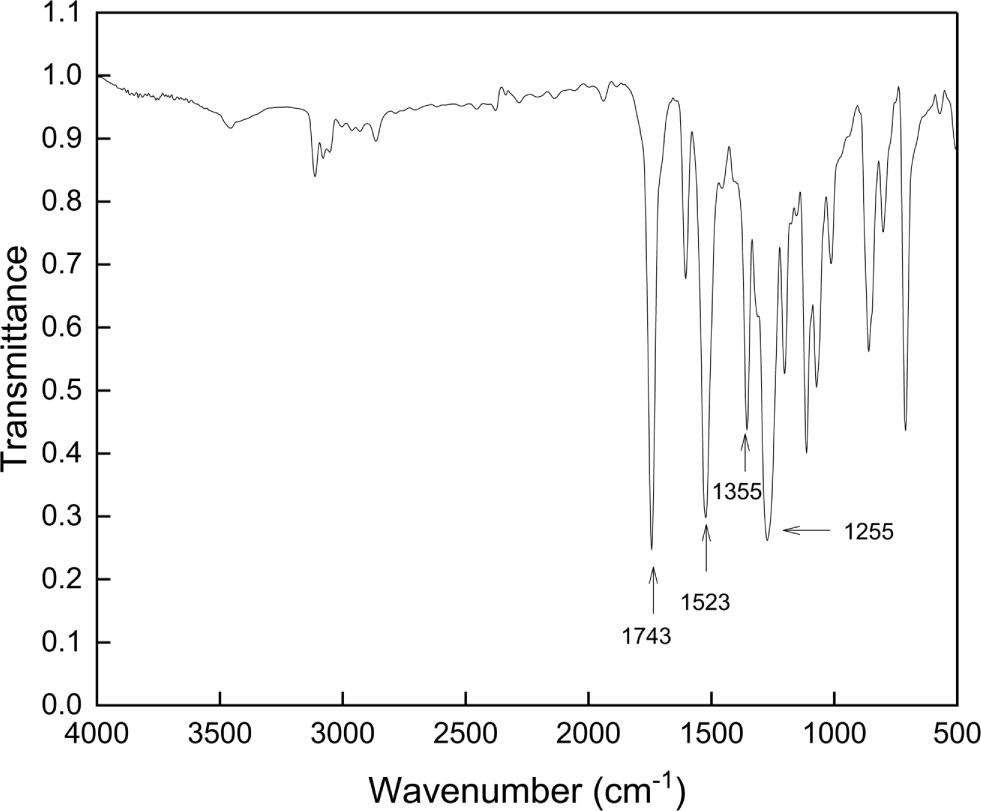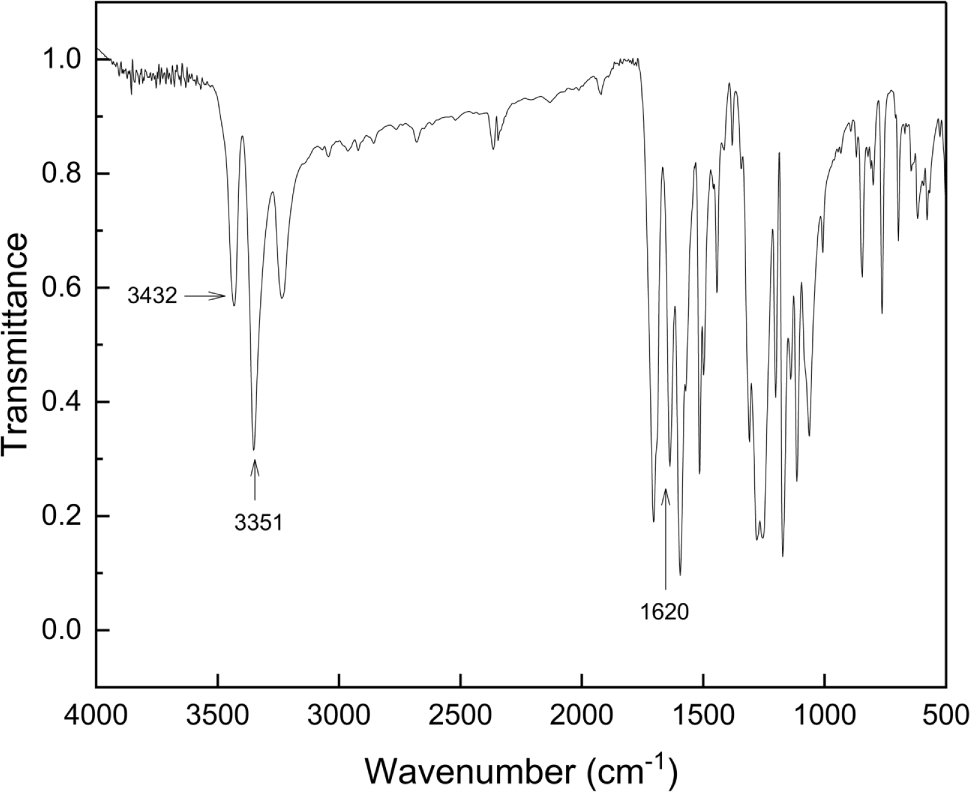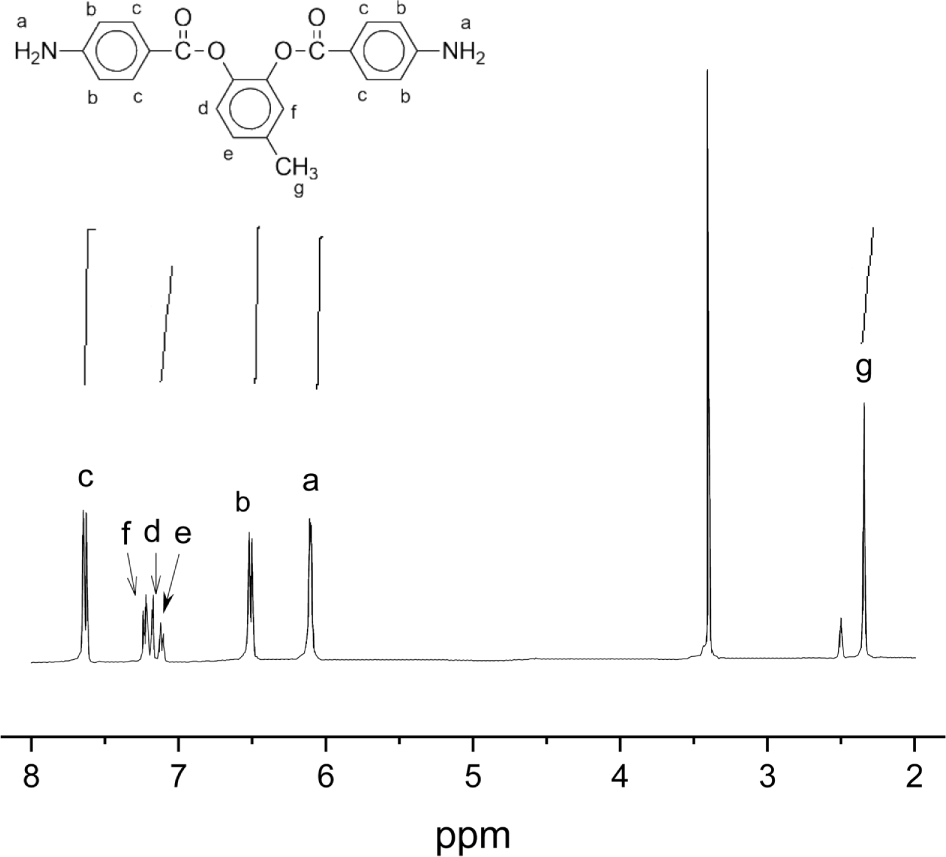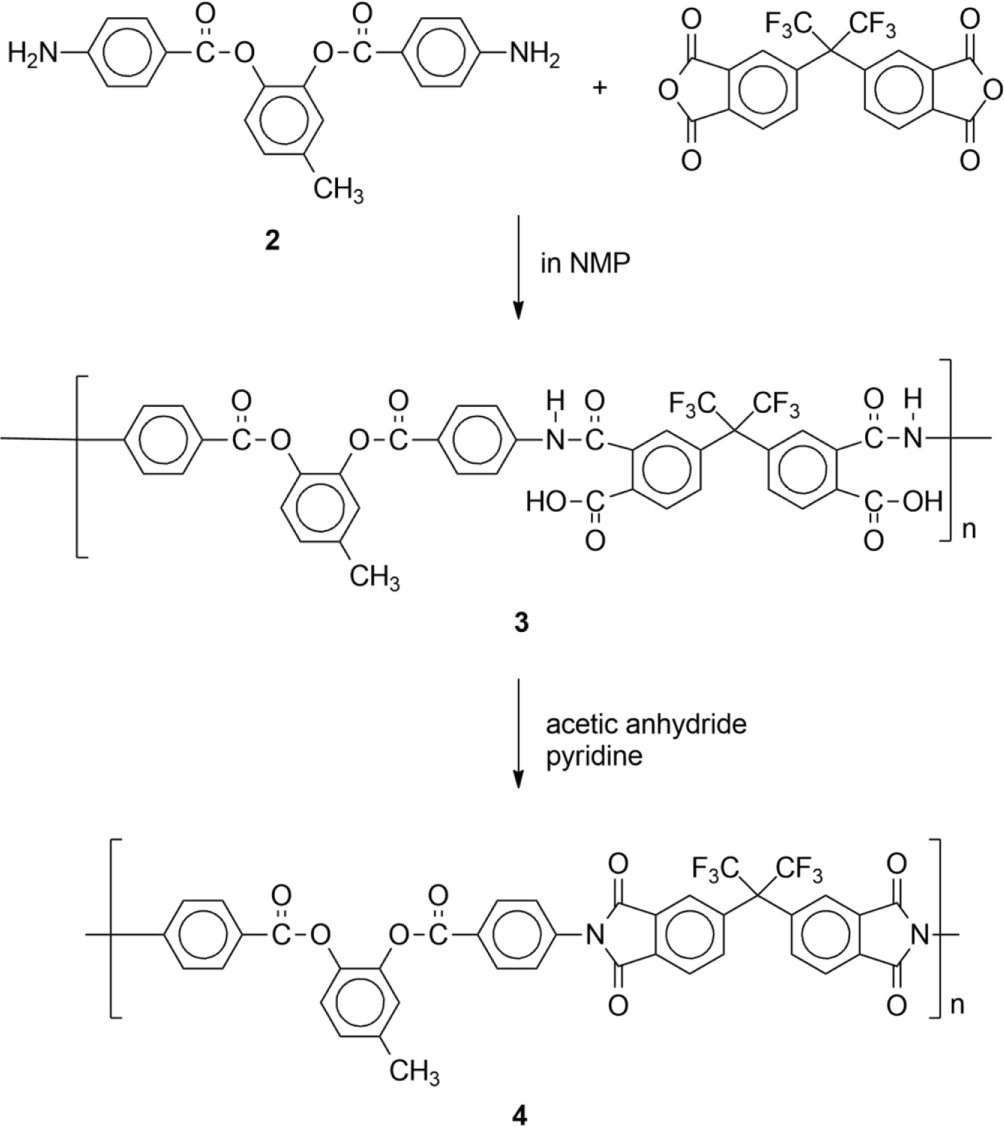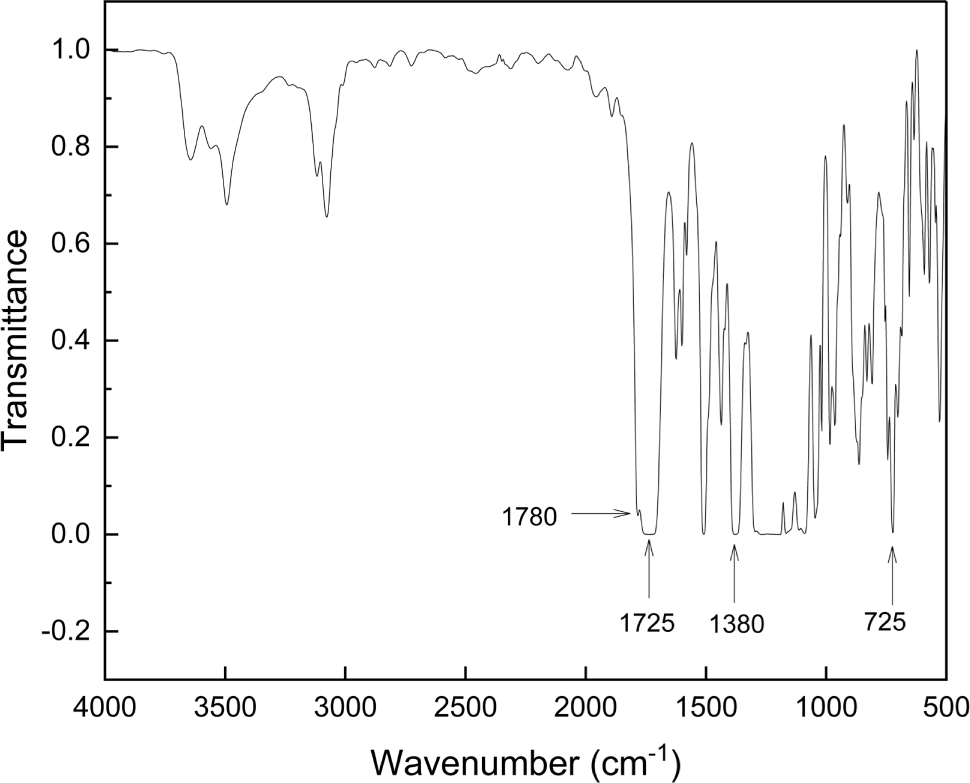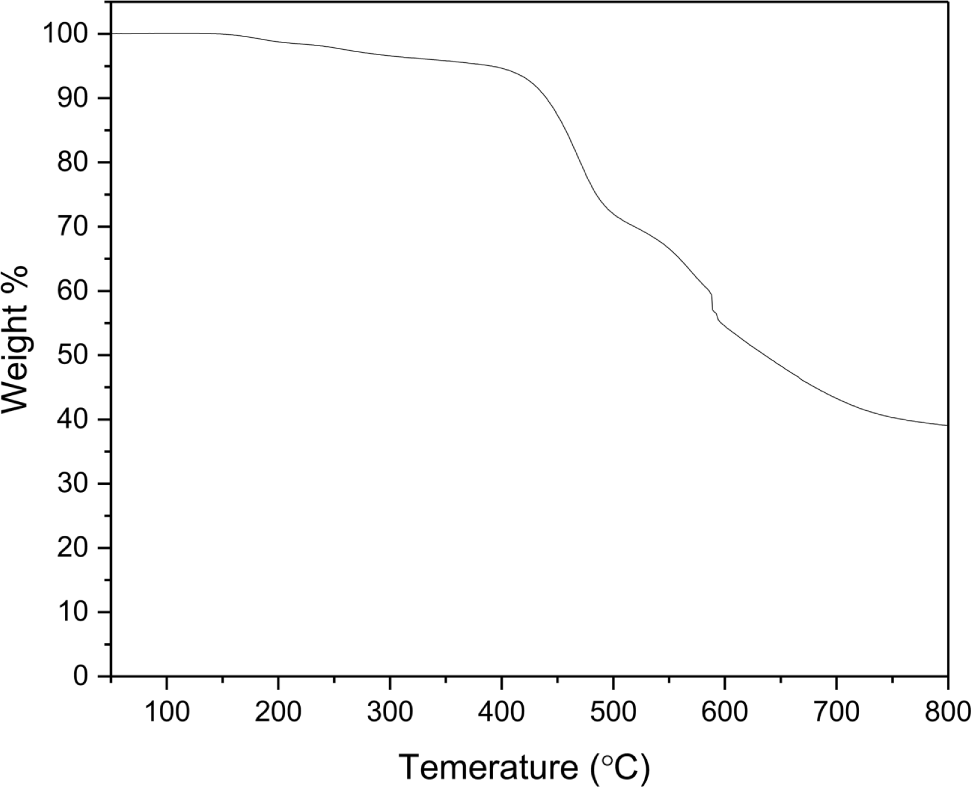Introduction
Aromatic polyimides are one of high-performance polymer that are known for excellent thermal stability and good physical properties, so they have been applied in high-tech fields such as aerospace and microelectronics industry.1,2 Especially in the microelectronics industry, aromatic polyimide has been used in various ways such as interlayer insulation of semiconductors, multi-layer film of electronic packaging, alignment film of liquid crystal display, optical wave guide, etc.3 Recently, flexible displays such as foldable, rollable and even stretchable become popular. Flexible displays are fabricated on transparent polymer substrate include polyethylene terephthalate,4,5 polyethylene naphthalate,6,7 polycarbonate8,9 and aromatic polyimide10-13 instead of ITO glass.
However, aromatic polyimides are difficult to process because they have high glass transition temperature (Tg) and melting temperature (Tm), and do not dissolve well in organic solvents. Aromatic polyimides have unique color ranging from light yellow to dark brown, which is because of the formation of an intra- or intermolecular charge transfer complex (CTC) between electron accepting dianhydride and electron donating diamine.14 Therefore, application of aromatic polyimides as substrate for flexible display is limited.
To overcome these problems, researches have been focused on the synthesis of processable and colorless polyimides without deterioration of their own excellent properties. These include introducing flexible linkage into the main chain, attaching large polar or non-polar substituents, or using noncoplanar or alicyclic monomers. As well known, introduction of ortho catenation into the main chain has led to aromatic polyimides with improved solubility and other desirable properties.15-17 The introduction of hexafluoroisopropylidene (6F) linkage is also known for enhancing processability and reducing color of aromatic polyimide. The 6F linkage increases the flexibility of the aromatic polyimide, breaks the conjugated structure, and hinders the formation of charge transfer complexes. On the other hand, since the covalent bond between carbon and fluorine is very strong, the thermal stability of aromatic polyimide does not decrease much.18
In this study, to develop novel substrate for flexible display, we synthesized an aromatic polyimide based on a new diamine with ortho catenation and methyl group. A diamine was prepared from the reaction of 4-methyl catechol with 4-nitrobenzoyl chloride and subsequent reduction. An aromatic polyimide was obtained from the polymerization of diamine with 4,4’-hexafluoroisopropylidenediphthalic anhydride (6FDA). The solubility, thermal stability and optical property of the aromatic polyimide were investigated.
Experimental
4-Methyl catechol and 4-nitrobenzoyl chloride were used as purchased from Aldrich. 4,4’-hexafluoroisopropylidene-diphthalic anhydride (6FDA, Aldrich) was sublimated at 230°C. N-Methyl-2-pyrrolidinone (NMP, Aldrich), ethyl acetate (Katayama Chemical Co.), dichloromethane (Junsei Chemical Co.), pyridine (Aldrich), acetic anhydride (J.T. Baker), acetone (Aldrich), and Pd/C (Aldrich) were used as purchased.
4-Methyl catechol (6.2 g, 0.05 mol), 4-nitrobenzoyl chloride (20.4 g, 0.11 mol), dichloromethane (250 mL), and pyridine (12 mL) were placed to a 500 mL three-necked round bottom flask equipped with a stirrer and a reflux condenser. The reaction mixture was heated to 40°C and refluxed for 5 h under N2. The reaction mixture was cooled to room temperature and dichloromethane was removed using a rotary evaporator. The solid product obtained was washed with 3% aqueous HCl solution, 3% aqueous KHCO3 solution, and distilled water, and dried under vacuum at 80°C for 24 h. The crude product was recrystallized from acetone to give white crystals (18.0 g, yield was 85%). The melting point was 139°C.
Under hydrogen atmosphere, 4-methyl-1,2-phenylene bis(4-nitrobenzoate) (1) (5.0 g) was dissolved in ethyl acetate (100 mL) and the mixture was stirred vigorously in the presence of Pd/C (0.2 g) for 4 hours at room temperature. Afterwards, the catalyst Pd/C was remove by filtration and the solution was concentrated under reduced pressure to afford solid. The crude product was recrystallized from ethanol to give crystals (2) (3.2 g, yield 75%). The melting point was 188°C.
4-Methyl-1,2-phenylene bis(4-aminobenzoate) (2) (0.6967 g, 2 mmol) and NMP (6.5 mL) were placed in a 250 mL three-necked flask equipped with a stirrer and a nitrogen inlet and the reaction mixture was stirred at 5°C under nitrogen atmosphere. After 4-methyl-1,2-phenylene bis(4-aminobenzoate) (2) was completely dissolved in NMP, 6FDA (0.4362 g, 2 mmol) was added and stirred at room temperature for 24 h yielding a clear and viscous solution of poly(amic acid) (3). The poly(amic acid) (3) was chemically imidized by addition of acetic anhydride and pyridine and subsequent heating at 40 8C for 24 h. The polyimide containing mixture was cooled to room temperature and then poured into ethanol, forming a precipitate that was collected by filtration. Washing with methanol followed by drying under vacuum afforded polyimide (4) as a powder.
Melting points were measured at a heating rate of 5°C/min on Mel-Temp 3.0 (Laboratory Devices INC., USA). FT-IR spectra of the compounds were obrained with a Brucker Vector 22 spectrophotometer using KBr pellet or film. 1H NMR spectrum of the diamine dissolved in DMSO-d6 was recorded on Jeol JNM-ECP 400 Spectrometer. Thermogravimetric anaysis (TGA) was performed on a Perkin Elmer TGA 7 system. TGA measurement was made at a heating rate of 10°C/min in N2. Light transmittance of the polyimide film was measured using a Hitachi (Japan) U-2001 UV-Visible Spectrophotometer.
Results and Discussion
The diamine, 4-methyl-1,2-phenylene bis(4-aminobenzoate), was synthesized in two steps by the condensation reaction of 4-methyl-catechol and 4-nitrobenzoyl chloride to obtain the nitro compound 4-methyl-1,2-phenylene bis(4-nitrobenzoate) (1), followed by reduction with hydrogen and Pd catalyst (Scheme 1). The structure of 4-methyl-1,2-phenylene bis(4-nitrobenzoate) (1) was confirmed by FT-IR spectroscopy and the structure of the diamine, 4-methyl-1,2-phenylene bis(4-aminobenzoate) (2), was identified by FI-IR and 1H-NMR spectroscopy. Figure 1 shows the FT-IR spectrum of 4-methyl-1,2-phenylene bis(4-nitrobenzoate). The FT-IR spectrum showed the absorption bands at 1743 (C=O asymmetric stretching), 1255 (C-O stretching), 1523 (N-O asymmetric stretching), and 1355 cm-1 (N-O symmetric stretching). Figure 2 is the FT-IR spectrum of 4-methyl-1,2-phenylene bis(4-aminobenzoate) (2). After reduction, the characteristic absorption of nitro groups disappeared and the characteristic absorption of amino groups at 3432 and 3351 (N-H stretching) and 1620 cm-1 (N-H bending) were observed. Figure 3 is the 1H-NMR spectrum of 4-methyl-1,2-phenylene bis(4-aminobenzoate) (2). Aromatic proton peaks with carbonyl group at 7.8 ppm, aromatic proton peaks adjacent to methyl group at 7.1 to 7.2 ppm, aromatic proton peaks close to amine groups at 6.5 ppm, amine proton peaks at 6.1 ppm, and methyl proton peaks at 2.3 ppm were observed. The integral value of NMR spectrum matched the number of protons in 4-methyl-1,2-phenylene bis(4-aminobenzoate) (2).
Polyimide was synthesized by the conventional two step polymerization method, as in Scheme 2, involving anhydride ring opening reaction forming poly(amic acid) and subsequently chemical cyclodehydration. The poly(amic acid) (3) was prepared by reacting stoichiometric amount of 4-methyl-1,2-phenylene bis(4-aminobenzoate) with 6FDA at a concentration of 16 wt% solid in NMP. The ring opening addition reaction at room temperature for 4 h yielded poly(amic acid) solution. After dilution of the solution to 7 wt%, subsequent chemical cyclodehydration with a mixture of pyridine and acetic anhydride gave the fully imidized polyimide (4). The polyimide was soluble in NMP and the molecular weight of polyimide (4) was high enough to cast tough, flexible, and transparent polyimide film.
The structure of the synthesized polyimide (4) was confirmed by FT-IR spectroscopy as shown in Figure 4. The absorption bands at 1780 (C=O asymmetric stretching), 1725 (C=O symmetric stretching), 1380 (C-N stretching), and 725 cm-1 (C=O bending) corresponding to the characteristic imide bands were observed.
Polyimides generally has a color ranging from brown to deep yellow because of charge-transfer complex (CTC). Polyimides generally have electron-rich diamine moieties serve as electron donors and electron-deficient dianhydride moieties as electron acceptors. When an electron donor is close to an electron acceptor, CTC forms and induces optical absorption at wavelengths in the visible range. Generally, there are two methods to decrease the color. One method is to modify polyimides with electronegative components such as fluorinated groups which reduce the electron density in the polymer chains and suppress CTC formation, and the other method is to incorporate bulky groups that introduce steric hindrance to interchain CTC formation. However, the bulky group also affects the macromolecular packing, and thus deteriorates the thermal stability and mechanical strength.
The film prepared by casting of the synthesized polyimide (4) were flexible, transparent, and colorless. The polyimide (4) has hexafluoroisopropylidene (6F) linkage in dianhydride moieties and ortho catenation and methyl group in diamine moieties. The 6F linkage changes the electron density of nearby functional groups and hinders π-electron conjugation of the polyimide and the increases the free volume of the polymer chain and hinders chain packing, so CTC can be diminished. The ortho catenation and methyl group decreases the conjugation of π electrons and increases the distance between the main chain of polyimide (4), resulting in a colorless polyimide. Figure 5 shows the light transmittance measurement results of a film of the polyimide (4). The films showed light transmittance of 80% or more in a wavelength region of 450 nm or more. The thermal stability of the synthesized polyimide (4) was evaluated by TGA. As shown in Figure 6, 5% weight loss was observed at 380°C in N2. It was confirmed that weight loss occurred at a lower temperature due to the effect of ortho catenation, 6F linkage, and pendant methyl group.
Conclusions
An aromatic diamine with ortho catenation and pendant methyl group was synthesized by reacting 4-methyl catechol with 4-nitrobenoyl chloride and subsequent reduction. The chemical structure of the obtained 4-methyl-1,2-phenylene bis(4-aminobenzoate) was confirmed by FT-IR and 1H-NMR. A polyimide was prepared by reacting 4-methyl-1,2-phenylene bis(4-aminobenzoate) with 6FDA, and chemical imidization. The obtained polyimide was dissolved in NMP and casted as a flexible, tough, and colorless film. As a result of TGA analysis, ortho catenation, 6F linkage, and pendant methyl group lowered the thermal stability of the polyimide.
